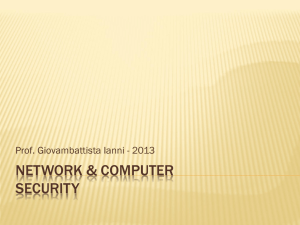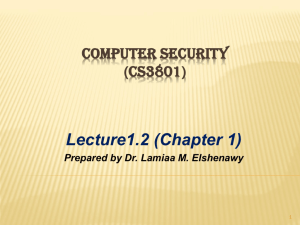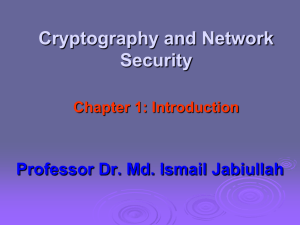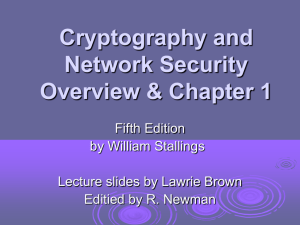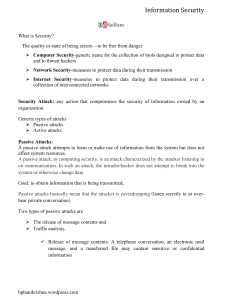Chapter 1 - WordPress.com
advertisement
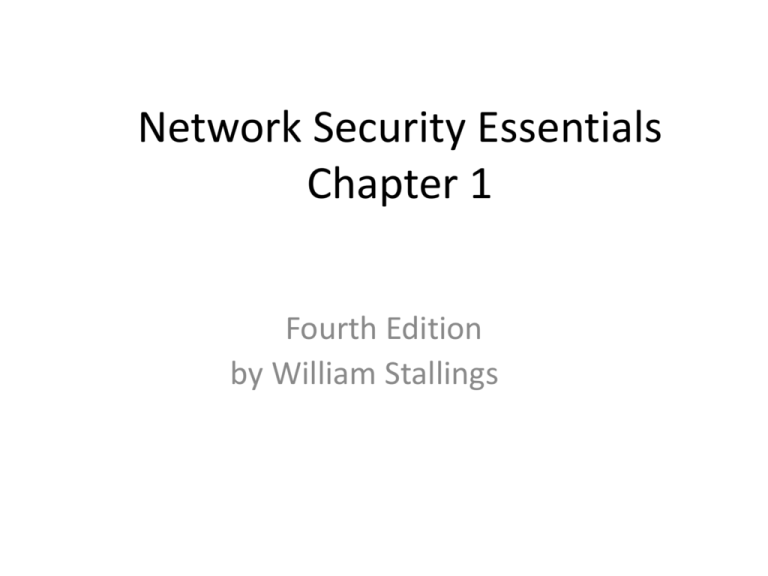
Network Security Essentials Chapter 1 Fourth Edition by William Stallings Computer Security • The protection afforded to an automated information system in order to attain the applicable objectives of preserving the integrity, availability and confidentiality of information system resources (includes hardware, software, firmware, information/data, and telecommunications) [NIST 1995] Key Security Concepts Three Key Objectives • Confidentiality – Data confidentiality – Privacy • Integrity – Data integrity – System integrity • Availability • Additional concepts – Authenticity – Accountability Levels of Impact • 3 levels of impact from a security breach – Low – Moderate – High Examples of Security Requirements • confidentiality – student grades • integrity – patient information • availability – authentication service Aspects of Security • 3 aspects of information security: – security attack – security mechanism: detect, prevent, recover – security service • terms – threat – a potential for violation of security – attack – an assault on system security, a deliberate attempt to evade security services Passive Attacks (1) Release of Message Contents Passive Attacks (2) Traffic Analysis • Passive attacks do not affect system resources – Eavesdropping, monitoring • Two types of passive attacks – Release of message contents – Traffic analysis • Passive attacks are very difficult to detect – Message transmission apparently normal • No alteration of the data – Emphasis on prevention rather than detection • By means of encryption Active Attacks (1) Masquerade Active Attacks (2) Replay Active Attacks (3) Modification of Messages Active Attacks (4) Denial of Service • Active attacks try to alter system resources or affect their operation – Modification of data, or creation of false data • Four categories – – – – Masquerade Replay Modification of messages Denial of service: preventing normal use • A specific target or entire network • Difficult to prevent – The goal is to detect and recover Security Service – enhance security of data processing systems and information transfers of an organization – intended to counter security attacks – using one or more security mechanisms – often replicates functions normally associated with physical documents • which, for example, have signatures, dates; need protection from disclosure, tampering, or destruction; be notarized or witnessed; be recorded or licensed Security Services • X.800: “a service provided by a protocol layer of communicating open systems, which ensures adequate security of the systems or of data transfers” • RFC 2828: “a processing or communication service provided by a system to give a specific kind of protection to system resources” Security Services (X.800) • Authentication - assurance that communicating entity is the one claimed – have both peer-entity & data origin authentication • Access Control - prevention of the unauthorized use of a resource • Data Confidentiality –protection of data from unauthorized disclosure • Data Integrity - assurance that data received is as sent by an authorized entity • Non-Repudiation - protection against denial by one of the parties in a communication • Availability – resource accessible/usable Security Mechanism • feature designed to detect, prevent, or recover from a security attack • no single mechanism that will support all services required • however one particular element underlies many of the security mechanisms in use: – cryptographic techniques • hence our focus on this topic Security Mechanisms (X.800) • specific security mechanisms: – encipherment, digital signatures, access controls, data integrity, authentication exchange, traffic padding, routing control, notarization • pervasive security mechanisms: – trusted functionality, security labels, event detection, security audit trails, security recovery Model for Network Security Model for Network Security • using this model requires us to: 1. design a suitable algorithm for the security transformation 2. generate the secret information (keys) used by the algorithm 3. develop methods to distribute and share the secret information 4. specify a protocol enabling the principals to use the transformation and secret information for a security service Model for Network Access Security Model for Network Access Security • using this model requires us to: 1. select appropriate gatekeeper functions to identify users 2. implement security controls to ensure only authorised users access designated information or resources

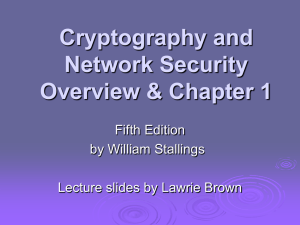

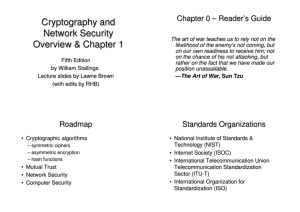
![Systems Assurance [Opens in New Window]](http://s3.studylib.net/store/data/007522633_2-e364c8f93e26286779d02c826b323ed6-300x300.png)
